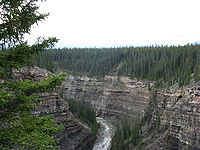.gif)
Bighorn River (Alberta)
Encyclopedia

River
A river is a natural watercourse, usually freshwater, flowing towards an ocean, a lake, a sea, or another river. In a few cases, a river simply flows into the ground or dries up completely before reaching another body of water. Small rivers may also be called by several other names, including...
originating in the Alberta
Alberta
Alberta is a province of Canada. It had an estimated population of 3.7 million in 2010 making it the most populous of Canada's three prairie provinces...
foothills, and is a tributary
Tributary
A tributary or affluent is a stream or river that flows into a main stem river or a lake. A tributary does not flow directly into a sea or ocean...
of the North Saskatchewan River
North Saskatchewan River
The North Saskatchewan River is a glacier-fed river that flows east from the Canadian Rockies to central Saskatchewan. It is one of two major rivers that join to make up the Saskatchewan River....
. The river
River
A river is a natural watercourse, usually freshwater, flowing towards an ocean, a lake, a sea, or another river. In a few cases, a river simply flows into the ground or dries up completely before reaching another body of water. Small rivers may also be called by several other names, including...
, as well as the nearby Bighorn Range and Bighorn Dam
Bighorn Dam
Bighorn Dam is a dam located in Clearwater County in west-central Alberta, Canada. It was built by TransAlta Corporation in 1972, and lead to the creation of Lake Abraham, Alberta's largest man-made lake....
are named for the Bighorn sheep
Bighorn Sheep
The bighorn sheep is a species of sheep in North America named for its large horns. These horns can weigh up to , while the sheep themselves weigh up to . Recent genetic testing indicates that there are three distinct subspecies of Ovis canadensis, one of which is endangered: Ovis canadensis sierrae...
which dominate the area. The name first appeared in 1865.
Flowing under Mount McGuire
Mount McGuire
For the mountain of a similar name near Chilliwack, British Columbia, see Mount McGuire .Mount McGuire is a mountain located in the Sunwapta River Valley of Jasper National Park, in Alberta, Canada....
, Bighorn River soon takes on Littlehorn and Sunkay Creeks, before plummeting over the impressive Crescent Falls
Crescent Falls
Crescent Falls are a series of two waterfalls located on the Bighorn River in west-central Alberta, Canada.The falls are located a few kilometres upstream of the river's confluence with the North Saskatchewan River. A 4.5 kilometer long trail leads north from David Thompson Highway to the falls...
. After the falls, the Bighorn travels through a significant canyon, before passing through the Bighorn Indian Reserve. The river
River
A river is a natural watercourse, usually freshwater, flowing towards an ocean, a lake, a sea, or another river. In a few cases, a river simply flows into the ground or dries up completely before reaching another body of water. Small rivers may also be called by several other names, including...
then empties into the North Saskatchewan River
North Saskatchewan River
The North Saskatchewan River is a glacier-fed river that flows east from the Canadian Rockies to central Saskatchewan. It is one of two major rivers that join to make up the Saskatchewan River....
after Lake Abraham.

